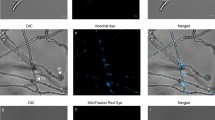Abstract
The Nicotiana tabacum lectin, called Nictaba, is a nucleocytoplasmic plant lectin expressed in tobacco leaves after exogenous application of specific jasmonates and upon insect herbivory. Since the lectin concentrations are rather low, huge amounts of plant material are needed to purify milligram quantities of the protein. In addition, the purified lectin fractions are always contaminated with low molecular weight compounds such as phenols. In an attempt to improve and facilitate the purification of the tobacco lectin in reasonable amounts, an in vitro-coupled transcription/translation system based on an Escherichia coli lysate was used to express the lectin gene. Recombinant expression levels could be enhanced by an adapted codon usage. Recombinant lectin was purified, biochemically characterized and found to be biologically active. The biological activity of the recombinant lectin towards insect epithelial midgut cells was clearly demonstrated in a functional bio-assay and the internal cellular localization was analyzed using immunocytochemical techniques.



Similar content being viewed by others
References
Berridge M. V.; Tan A. S. Characterization of the cellular reduction of 3-(4,5)-dimethylthiazol-2-yl)-2,5-diphenyltetrazolium bromide (MTT): subcellular localization, substrate dependence, and involvement of mitochondrial electron transport in MTT reduction. Arch. Biochem. Biophys. 2: 474–482; 1993. DOI 10.1006/abbi.1993.1311.
Betton J. M. Rapid translation system (RTS): a promising alternative for recombinant protein production. Curr. Protein Pept. Sci. 4: 73–80; 2003. Medline. DOI 10.2174/1389203033380359.
Chen Y.; Peumans W. J.; Hause B.; Bras J.; Kumar M.; Proost P.; et al. Jasmonic acid methyl ester induces the synthesis of a cytoplasmic/nuclear chitooligosaccharide-binding lectin in tobacco leaves. FASEB J. 16: 905–907; 2002. Medline.
Hakim R. S.; Blackburn M. B.; Corti P.; Gelman D. B.; Goodman C.; Elsen K.; et al. Growth and mitogenic effects of arylphorin in vivo and in vitro. Arch. Insect Biochem. Physiol. 64: 63–73; 2007. Medline. DOI 10.1002/arch.20155.
Hoffmann M.; Nemetz C.; Madin K.; Buchberger B. Rapid translation system: a novel cell-free way from gene to protein. Biotechnol. Annu. Rev. 10: 1–30; 2004. Medline. DOI 10.1016/S1387-2656(04)10001-X.
Laemmli U. K. Cleavage of structural proteins during the assembly of the head of bacteriophage T4. Nature 227: 680–685; 1970. Medline. DOI 10.1038/227680a0.
Lannoo N.; Peumans W. J.; Van Damme E. J. M. The presence of jasmonate-inducible lectin genes in some but not all Nicotiana species explains a marked intragenus difference in plant responses to hormone treatment. J. Exp. Bot. 57: 3145–3155; 2006a. Medline. DOI 10.1093/jxb/erl076.
Lannoo N.; Peumans W. J.; Van Pamel E.; Alvarez R.; Xiong T. C.; Hause G.; et al. Localization and in vitro binding studies suggest that the cytoplasmic/nuclear tobacco lectin can interact in situ with high-mannose and complex N-glycans. FEBS Lett. 580: 6329–6337; 2006b. Medline. DOI 10.1016/j.febslet.2006.10.044.
Lannoo N.; Vandenborre G.; Miersch O.; Smagghe G.; Wasternack C.; Peumans W. J.; et al. The jasmonate-induced expression of the Nicotiana tabacum leaf lectin. Plant Cell Physiol. 48: 1207–1218; 2007. Medline. DOI 10.1093/pcp/pcm090.
Peumans W. J.; Barre A.; Hao Q.; Rougé P.; Van Damme E. J. M. Higher plants developed structurally different motifs to recognize foreign glycans. Trends Glycosci. Glyco. 12: 83–101; 2000.
Peumans W. J.; Van Damme E. J. M. Lectins as plant defense proteins. Plant Physiol. 109: 347–352; 1995. Medline. DOI 10.1104/pp.109.2.347.
Van Damme E. J. M.; Barre A.; Rougé P.; Peumans W. J. Cytoplasmic/nuclear plant lectins: a new story. Trends Plant Sci. 9: 484–489; 2004. Medline. DOI 10.1016/j.tplants.2004.08.003.
Van Damme E. J. M.; Lannoo N.; Fouquaert E.; Peumans W. J. The identification of inducible cytoplasmic/nuclear carbohydrate-binding proteins urges to develop novel concepts about the role of plant lectins. Glycoconj. J. 20: 449–460; 2003. Medline. DOI 10.1023/B:GLYC.0000038291.67527.a5.
Van Damme E. J. M.; Peumans W. J.; Barre A.; Rougé P. Plant lectins: a composite of several distinct families of structurally and evolutionary related proteins with diverse biological roles. Crit. Rev. Plant Sci. 17: 575–692; 1998. DOI 10.1016/S0735-2689(98)00365-7.
Van Damme E. J. M.; Rougé P.; Peumans W. J. Carbohydrate–protein interactions: plant lectins. In: KamerlingJ. P.; BoonsG. J.; LeeY. C.; SuzukiA.; TaniguchiN.; VoragenA. G. J. (eds) Comprehensive glycoscience—from chemistry to systems biology. Elsevier, New York, pp 563–599; 2007.
Acknowledgements
This research was supported by project 3G016306 of Fund for Scientific Research (FWO-Vlaanderen, Brussels, Belgium), the Research Council of Ghent University and the IWT-Flanders (SB/51099/Vandenborre). The authors acknowledge the gift of FPMI-CF-203/2.5 cells by G.F. Caputo (Great Lakes Forestry Centre, Sault Ste. Marie, ON, Canada).
Author information
Authors and Affiliations
Corresponding author
Additional information
Editor: J. Denry Sato
Rights and permissions
About this article
Cite this article
Vandenborre, G., Lannoo, N., Smagghe, G. et al. Cell-free expression and functionality analysis of the tobacco lectin. In Vitro Cell.Dev.Biol.-Animal 44, 228–235 (2008). https://doi.org/10.1007/s11626-008-9123-z
Received:
Accepted:
Published:
Issue Date:
DOI: https://doi.org/10.1007/s11626-008-9123-z




